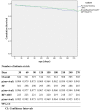Breastfeeding with maternal antiretroviral therapy or formula feeding to prevent HIV postnatal mother-to-child transmission in Rwanda
- PMID: 19730349
- PMCID: PMC3305463
- DOI: 10.1097/QAD.0b013e32832ec20d
Breastfeeding with maternal antiretroviral therapy or formula feeding to prevent HIV postnatal mother-to-child transmission in Rwanda
Abstract
Objective: To assess the 9-month HIV-free survival of children with two strategies to prevent HIV mother-to-child transmission.
Design: Nonrandomized interventional cohort study.
Setting: Four public health centres in Rwanda.
Participants: Between May 2005 and January 2007, all consenting HIV-infected pregnant women were included.
Intervention: Women could choose the mode of feeding for their infant: breastfeeding with maternal HAART for 6 months or formula feeding. All received HAART from 28 weeks of gestation. Nine-month cumulative probabilities of HIV transmission and HIV-free survival were determined using the Kaplan-Meier method and compared using the log-rank test. Determinants were analysed using a Cox model analysis.
Results: Of the 532 first-liveborn infants, 227 (43%) were breastfeeding and 305 (57%) were formula feeding. Overall, seven (1.3%) children were HIV-infected of whom six were infected in utero. Only one child in the breastfeeding group became infected between months 3 and 7, corresponding to a 9-month cumulative risk of postnatal infection of 0.5% [95% confidence interval (CI) 0.1-3.4%; P = 0.24] with breastfeeding. Nine-month cumulative mortality was 3.3% (95% CI 1.6-6.9%) in the breastfeeding arm group and 5.7% (95% CI 3.6-9.2%) for the formula feeding group (P = 0.20). HIV-free survival by 9 months was 95% (95% CI 91-97%) in the breastfeeding group and 94% (95% CI 91-96%) for the formula feeding group (P = 0.66), with no significant difference in the adjusted analysis (adjusted hazard ratio for breastfeeding: 1.2 (95% CI 0.5-2.9%).
Conclusion: : Maternal HAART while breastfeeding could be a promising alternative strategy in resource-limited countries.
Conflict of interest statement
Figures
Comment in
-
HAART during pregnancy and during breastfeeding among HIV-infected women in the developing world: has the time come?AIDS. 2009 Nov 27;23(18):2473-7. doi: 10.1097/QAD.0b013e328333866c. AIDS. 2009. PMID: 19838097 No abstract available.
References
-
- European Collaborative Study. Mother-to-child transmission of HIV infection in the era of Highly Active Antiretroviral Therapy. Clin Infect Dis. 2005;40:458–65. - PubMed
-
- Palombi L, Marazzi MC, Voetberg A, Magid NA. Treatment acceleration program and the experience of the DREAM program in prevention of mother-to-child transmission of HIV. AIDS. 2007;21(Suppl 4):65–S71. - PubMed
-
- Coovadia HM, Rollins NC, Bland RM, Little K, Coutsoudis A, Bennish ML, et al. Mother-to-child transmission of HIV-1 infection during exclusive breastfeeding in the first 6 months of life: an intervention cohort study. Lancet. 2007;369:1107–16. - PubMed
-
- Thior I, Lockman S, Smeaton LM, Shapiro RL, Wester C, Heymann SJ, et al. Breastfeeding plus infant zidovudine prophylaxis for 6 months vs formula feeding plus infant zidovudine for 1 month to reduce mother-to-child HIV transmission in Botswana: a randomized trial: the Mashi Study. JAMA. 2006;296:794–805. - PubMed
-
- Magoni M, Bassani L, Okong P, Kituuka P, Germinario EP, Giuliano M, et al. Mode of infant feeding and HIV infection in children in a program for prevention of mother-to-child transmission in Uganda. AIDS. 2005;19:433–7. - PubMed



